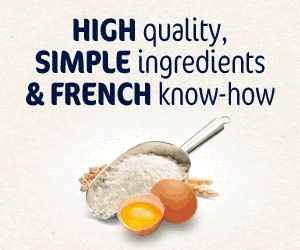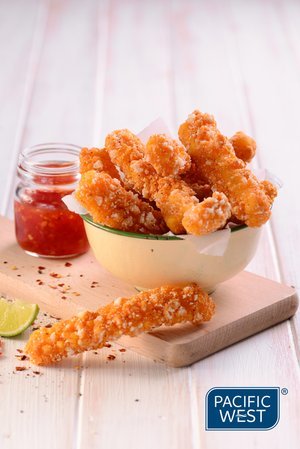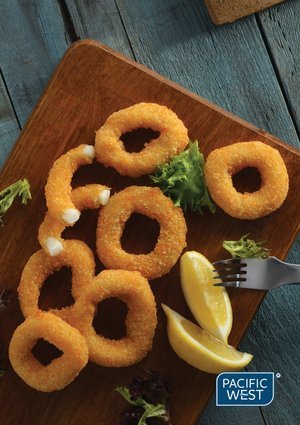Seafood innovations help drive profit while saving on labour and prep time
/Seafood is still as popular as ever on our foodservice menus, with presentation styles having evolved away from old school batters and towards lighter crumbs, often with an Asian influence. At the same time, the growing awareness among consumers of the importance of seafood sustainability has led to a greater focus on provenance – where the seafood is sourced from, and how it’s caught and processed. This presents an opportunity to differentiate your menu offerings from the competition by telling the story of how the customer’s meal has reached their plate.
The current staff and skills shortage in foodservice is also driving innovation in the category, says David White, Executive Chef at Simplot Australia which markets seafood products under the I&J and Captain’s Catch brands.
“Offering seafood as a platter, a share plate or bar snacks can be very profitable and is fairly easy to pull together”
— David White, Simplot Australia
“Not only can many foodservice venues not get the staff, but the staff they do have aren’t necessarily as skilled up as in the past, and for that reason menus are simplifying,” David explains. “The question for operators then becomes: how do I maintain a quality offering which keeps my customers coming back with the staff and resources available to me?
“One way to do that is to look to external suppliers to save you some labour and prep time through quality value added product. If you can confidently buy a product that’s of good quality, one you’re proud to call your own or that you can maybe put your own twist on via a garnish, spice or seasoning, that’s a great benefit. And this is really driving innovation in the seafood category.”
I&J Crispy Battered HOKI 140g FillETS
Demand for share plates and grazing menus on the rise
Another relevant trend is the demand for share plates, grazing menus or tapas, as David acknowledges: “Whichever term you like to use, it’s all the same thing and while you might think of tapas as Spanish, for example, it’s also very common to have shared menus in many Asian cuisines, and I think that has driven much of the integration into our food culture. In any case, it’s a trend that’s not going away and is definitely relevant to seafood. Offering seafood as a platter, a share plate or bar snacks can be very profitable and is fairly easy to pull together.
“For example, people recognise fish species like snapper, flathead and whiting and they know the taste and quality will be there, so that kind of value added seafood is always a safe bet on the menu. The I&J quality seafood range has products that are recognised species, they’ve been hand-dipped to evoke from-scratch presentation styles, they’re quick and easy to cook – and it’s a very extensive selection, everything from fish fillets to squid rings to prawns, so you can easily build a fisherman’s basket or seafood platter.
“If you’re a smart operator you’ll be looking at what you can do in this space to save on time and labour without lowering your quality standards”
I&J Salt & Cracked BLACK PEPPER SQUID
“What we’ll often see in the pub and club space is they will offer a hybrid platter, consisting of maybe some blue swimmer crab, grilled hoki, oysters and mussels on one side with some value added seafood like deep fried snapper or flathead on the other – that saves labour and prep time and you’ve good a selection of both fresh and frozen products which complement each other. If you’re a smart operator you’ll be looking at what you can do in this space to save on time and labour without lowering your quality standards, and value added seafood is great because it does allow you to add your own finishing touches.”
Frozen seafood provides assurance of ongoing supply
And while the supply chain issues of the past years are gradually easing back to normal, the frozen seafood category was never as badly affected as some others. “You’ve got 18 months to two years’ shelf life on some frozen seafood products,” David explains, “so we were able to manage stocks well throughout that timeframe, as fisheries operate all year round unlike vegetables and fruits which need to be harvested at peak seasonality. And freezing using today’s technology is really the perfect preservation method – you get great longevity and no loss of quality. We know that some operators are nervous about longterm product availability across some categories, but with frozen seafood you do have the assurance that supply won’t be as volatile across the supply chain, so you can be confident to keep it on the menu.”
A further drawcard for seafood is its popularity on the dine-out menu. “We know Australians have a love affair with seafood but it can sometimes be a little intimidating to cook at home, so we do find people are more likely to order it when they’re out because they trust a chef to do it for them,” David says. “My wife’s a good example – she doesn’t cook a lot of seafood at home but nine times out of ten she’ll order it out. So it is a popular eating dish and it should be on your menu because customers are always looking for it.”
“Stocking up on seafood for your sides menu can really drive profit”
GRAZING BOARD with I&J Flathead FISH BITES
The latest additions to the I&J product range are South American Crispy Battered Flathead Fish Bites and Crispy Battered Snapper Bites, both of which have been developed to tie in to the demand for smaller portion sizes which can be served on share plates, for snacking and finger food, and as side dishes.
“We know from talking to café and pub operators that sides are really profitable for them,” David points out. “The bigger the side menu, the better – so why not have a side of Snapper Bites as an add-on for the table, rather than wedges or chips? Stocking up on seafood for your sides menu can really drive profit.”
Sticking to the tried and true performers
Neil Cane, Innovation Manager at major seafood supplier Pacific West, echoes David’s comments about supply coming back on track post-Covid, adding: “I think the big trend right now in the pub and club market is operators are tending to be a little risk-averse, they’re not wanting to take a chance on anything different but rather sticking to the tried and true performers, and with the skill level down in the kitchen that’s understandable.
“Certainly value added seafood which you can take straight from the freezer to the fryer is in major demand because it delivers portion control, convenience and no wastage and it frees up your staff to do other things. Wastage minimisation is essential for cost control and return on investment is also very important – chefs need to be getting a good return on the menu for what they’re paying out, and quality frozen seafood gives you that.”
With consumer awareness of the importance of seafood sustainability on the rise, the provenance of seafood has also become a talking point on menus, as Neil explains: “Highlighting the provenance of seafood gives the opportunity for front of house staff to weave a story around the product on the menu and try to upsell – customers are more and more interested in where their food is coming from, so menu call-outs are becoming a thing. We first saw this on beef with wagyu and angus and now it’s filtering through to seafood.”
“Products like squid, prawns and scallops are all the right size for an entrée but can just as easily be served for mains”
— Neil Cane, Pacific West
He emphasises that a strong part of value added seafood’s menu appeal is its versatility: “Products like squid, prawns and scallops are all the right size for an entrée but can just as easily be served for mains. Seafood is highly versatile, it’s not just one big centre of plate – you wouldn’t want to share a steak with someone, but you’d be happy to share a plate of calamari!”
Pacific West maintains its diverse product portfolio, including a range of value added calamari products – such as chilli squid, salt and pepper squid, panko squid rings and natural squid the chef can cut and finish in their own way.
“There’s also prawns in panko, coconut or tempura crumb and the old favourite crumbed prawn cutlets – Neil says, “all can be used for share plates, individual entrees or even toppers on a main course, so you can get versatility and variety from the one product.”













